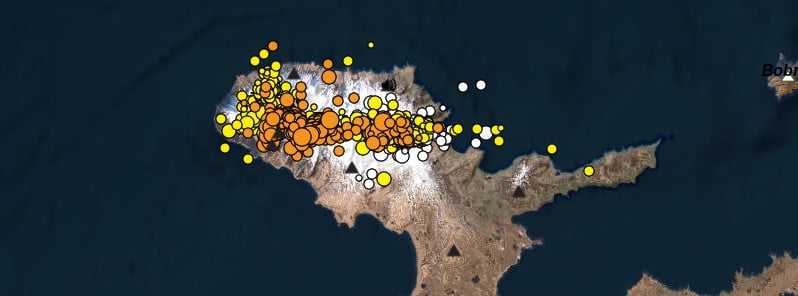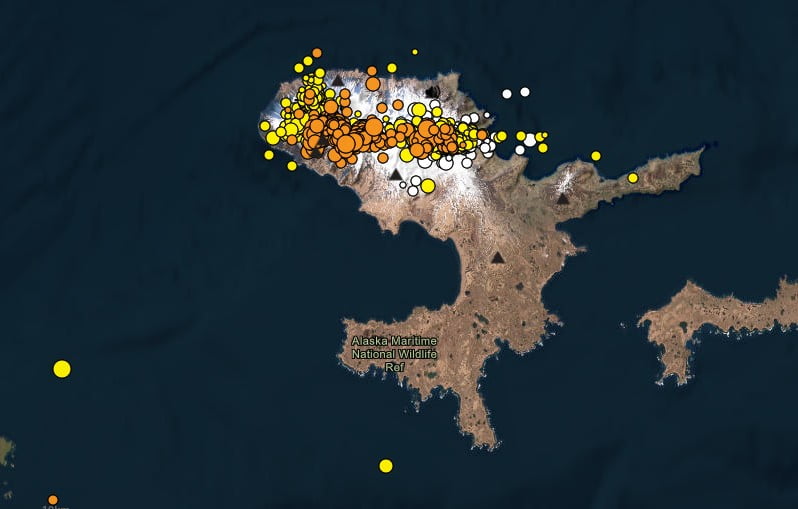AVO raises alert level for Tanaga and Takawangha volcanoes amid increased seismic activity, Alaska

Seismic activity beneath the Tanaga and Takawangha volcanoes on Tanaga Island, Alaska, approximately 8 kilometers (5 miles) apart, has increased the potential for eruption and prompted the Alaska Volcano Observatory (AVO) to raise the Aviation Color Code to ORANGE and the Volcano Alert Level to WATCH for both volcanoes on March 10, 2023.
If an eruption were to occur, it is uncertain at this stage if it would come from Tanaga or Takawangha, AVO said, adding that their analysts continue to monitor the situation closely, and locate events as time permits.1, 2
Earthquakes are occurring under Tanaga Island at a rate of up to several per minute, AVO said. The largest event in 24 hours to 02:22 UTC on March 10 was a M3.9.
No eruptive activity or signs of unrest have been detected in satellite or other monitoring data.
Both volcanoes are monitored with a local seismic network, a single local infrasound sensor, regional infrasound and lightning sensors, and satellite imagery.

According to the Global Volcanism Program (GVP), the last known eruption at Tanaga Volcano occurred in 1914-1915, and the last known eruption at Takawangha Volcano occurred in 1550 CE ± 50 years.
Geological summaries
Tanaga
Tanaga volcano, the second largest volcanic center of the central Aleutians, is the central and highest of three youthful stratovolcanoes oriented along a roughly E-W line at the NW tip of Tanaga Island. Ridges to the east and south represent the rim of an arcuate caldera formed by collapse of an ancestral edifice during the Pleistocene. Most Holocene eruptions originated from Tanaga volcano itself, which consists of two large cones, the western of which is the highest, constructed within a caldera whose 400 m (1 312 feet) high rim is prominent to the SE. At the westernmost end of the complex is conical Sajaka, a double cone that may be the youngest of the three volcanoes. Sajaka One volcano collapsed during the late Holocene, producing a debris avalanche that swept into the sea, after which the Sajaka Two cone was constructed within the collapse scarp.
Takawangha
Takawangha is a youthful volcano with an ice-filled caldera on northern Tanaga Island, near the western end of the Andreanof Islands. It lies across a saddle from historically active Tanaga volcano to the west; older, deeply eroded volcanoes lie adjacent to the east. The summit of the dominantly basaltic to basaltic-andesite volcano is largely ice covered, with the exception of five Holocene craters that during the last few thousand years produced explosive eruptions and lava flows that reached the lower flanks. No historical eruptions are known, although radiocarbon dating indicates explosive eruptions have occurred within the past several hundred years.
References:
1 Tanaga – AVO/USGS Volcanic Activity Notice – March 10, 2023
2 Takawangha – AVO/USGS Volcanic Activity Notice – March 10, 2023
3 Tanaga – Geological summary – GVP
4 Takawangha – Geological summary – GVP
Featured image credit: USGS/AVO, The Watchers

Commenting rules and guidelines
We value the thoughts and opinions of our readers and welcome healthy discussions on our website. In order to maintain a respectful and positive community, we ask that all commenters follow these rules.